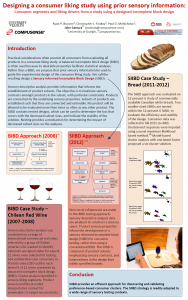Designing a consumer liking study using prior sensory information: consumer segments and liking drivers from a study using a designed incomplete block design
 Practical considerations often prevent all consumers from evaluating all products in a consumer liking study. A balanced incomplete block design is often used because its desirable properties facilitate statistical analyses. A consumer study (n=400) on 12 commercially available sliced white breads was planned to identify consumer segments, and the sensory properties that drive their hedonic responses. A sensory descriptive panel was used to perform descriptive analysis, yielding sensory profiles of the 12 breads. These sensory profiles were then used to construct a 12-present-6 designed incomplete block design. Subsets were composed to maximize sensory contrasts amongst products in the subset, with particular constraints. For example, to moderate the unbalancedness of the experimental design, no product was allowed to be evaluated more than twice as often as another product. Subsets of products were connected by the underlying sensory properties, rather than being evaluated in subsets containing each of the other samples an equal number of times. The subsets were constructed such that a 12-present-4 experiment was nested in the 12-present-6 experiment, and a 12-present-3 experiment was nested in the 12-present-4 experiment. Data were collected from consumers (n=400) and various cluster analyses were performed. Consumer segments were obtained and interpreted based on the mean liking score for each of the products and their sensory profiles. Model-based cluster analysis with one latent factor proposed a five-cluster solution. Nested designs were further analyzed to determine the loss that occurs with the decreased subset sizes, and indicate the stability of the solution. The approach described here is novel in that prior sensory information is utilized in a systematic way to produce nested designed incomplete block designs for the consumer study, which in turn provide a mechanism for determining the impact of decreased subset sizes on the analyses.
Practical considerations often prevent all consumers from evaluating all products in a consumer liking study. A balanced incomplete block design is often used because its desirable properties facilitate statistical analyses. A consumer study (n=400) on 12 commercially available sliced white breads was planned to identify consumer segments, and the sensory properties that drive their hedonic responses. A sensory descriptive panel was used to perform descriptive analysis, yielding sensory profiles of the 12 breads. These sensory profiles were then used to construct a 12-present-6 designed incomplete block design. Subsets were composed to maximize sensory contrasts amongst products in the subset, with particular constraints. For example, to moderate the unbalancedness of the experimental design, no product was allowed to be evaluated more than twice as often as another product. Subsets of products were connected by the underlying sensory properties, rather than being evaluated in subsets containing each of the other samples an equal number of times. The subsets were constructed such that a 12-present-4 experiment was nested in the 12-present-6 experiment, and a 12-present-3 experiment was nested in the 12-present-4 experiment. Data were collected from consumers (n=400) and various cluster analyses were performed. Consumer segments were obtained and interpreted based on the mean liking score for each of the products and their sensory profiles. Model-based cluster analysis with one latent factor proposed a five-cluster solution. Nested designs were further analyzed to determine the loss that occurs with the decreased subset sizes, and indicate the stability of the solution. The approach described here is novel in that prior sensory information is utilized in a systematic way to produce nested designed incomplete block designs for the consumer study, which in turn provide a mechanism for determining the impact of decreased subset sizes on the analyses.
![]()
Findlay, C. J., Browne, R. P., McNicholas, P. D., Li, M., & Castura, J. C. (2012). Designing a consumer liking study using prior sensory information: Consumer segments and liking drivers from a study using a designed incomplete block design. In: A Sense of Inspiration: 5th European Conference on Sensory Consumer Science of Food and Beverages. 9-12 September. Bern, Switzerland.